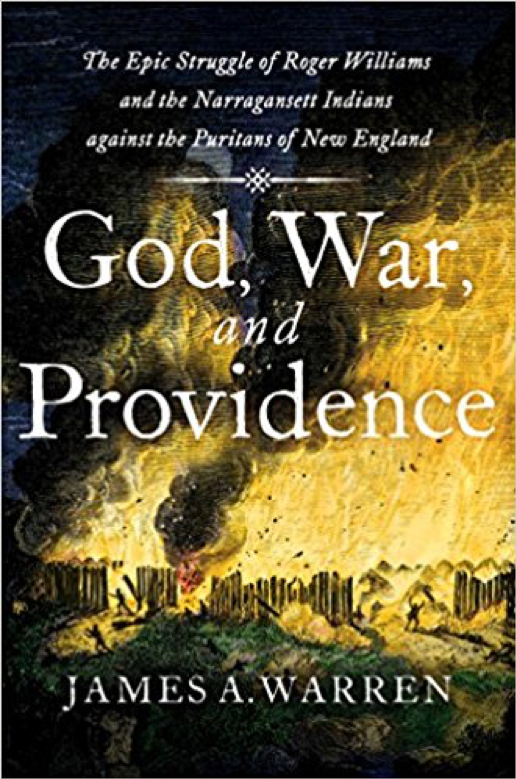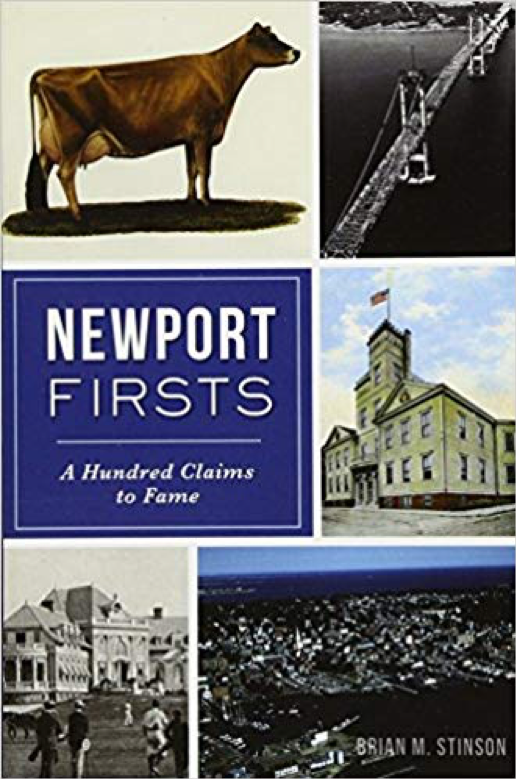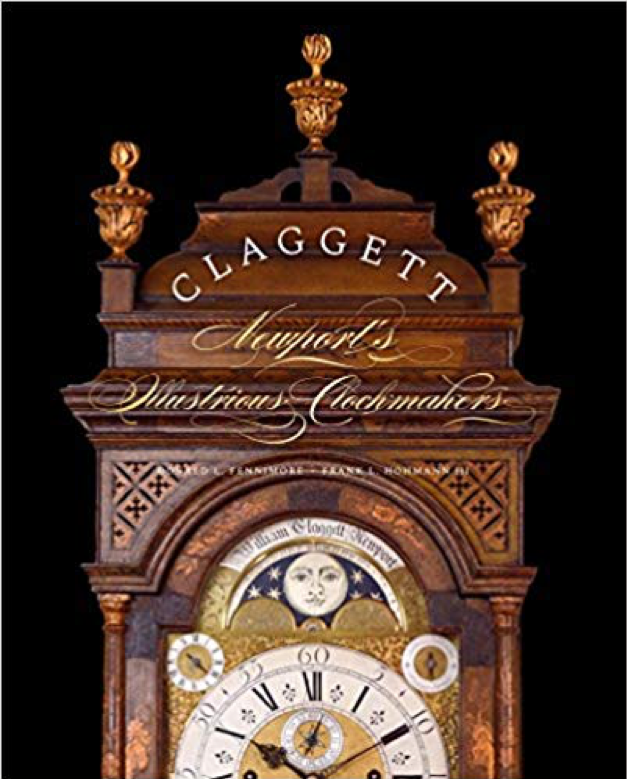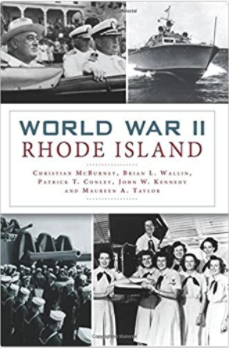The year 2018 was not a particularly strong year for the publication of Rhode Island history books. Next year is shaping up to be a banner year, I hear. But Russell DeSimone and I did find some books we would like to bring to your attention. Do keep them in mind as gifts for the holidays! Many of these books are available at Rhode Island independent bookstores and history museum gift shops (we like to support these two sources and hope you do too).
Book Reviews by Christian McBurney:
Jill Farinelli. The Palatine Wreck. The Legend of the New England Ghost Ship (University Press of New England, $19.95, paperback, 232 pages). OK, it was released in late 2017, but I did not become aware of it until 2018. I choose it as my Rhode Island history book of the year. It is really two books in one. The first part of the book describes the dreadful experiences of thousands of ordinary German immigrants from the Palatine region of Germany in the early part of the eighteenth century making their tortuous journey to the New World, mostly to the colony of Pennsylvania, to which many other German immigrants had already immigrated. The sufferings they underwent at each stage of the journey were awful. The death rate on the crowded transport ships sometimes even rivaled that of captive Africans stowed on slave ships making their way across the terrible Middle Passage to North America. The research the author has done to record the experiences of German immigrants is amazing.
Two days after Christmas in 1738, a British transport ship carrying immigrants from the Palatine region grounded in a blizzard on the tip of Block Island. The 105 passengers and crew on board were now castaways. Frozen, sick and starving, they were all that remained of the original 340 or more. More would die, in part because of the selfish ship captain. Block Island residents helped to save as many as they could, but some criticism arose about their conduct. A legend emerged from the wreck: a fiery ghost ship would be seen drifting in Block Island Sound. The author deftly deals with each of the supposed sightings, separating fact from fiction.
One of my favorite passages deals with Joseph P. Hazard, a wealthy textile manufacturer residing in Narragansett. The author writes: “He told the Narragansett Times that the light first came into view some two miles off the coast. He thought it was an ordinary ship until it turned red and raced toward the shore. As the light expanded, it became less bright, and pitched and plunged as if riding the crests of mighty storm-tossed waves, even though the ocean that night was smooth as a lake.” Later, the author writes, “Hazard’s fascination with the legend was fueled by his devotion to the Spiritualist movement, which was on full display at his estate: one room in his home was designed for séances, and a 105-foot towner had been built next door so he could more easily converse with his ancestors in the spirit world.. He’d also had a guest house built on the property at the behest of some druids whom he claimed had visited him in a dream.”
The book is smoothly written and very well researched. A freelance writer, Jill Farinelli began her book after spending a week with friends on Block Island ten years before her book was published.
Click here to buy The Palatine Wreck on amazon.com:
Here is a link to a book review I did earlier in the year. On my list, it is a close runner-up for top Rhode Island history book of the year.
James A. Warren, God War, and Providence: The Epic Struggle of Roger Williams and the Narragansett Indians against the Puritans of New England (Scribner, $30 and $20, hardback and paperback, 304 pages). To see my review, go to: http://smallstatebighistory.com/god-war-providence-book-review-christian-mcburney/
Click here to buy God, War and Providence on amazon.com:
Brian M. Stinson. Newport Firsts: A Hundred Claims to Fame (History Press, $21.95, paperback, 208 pages).
Newport has been a city of innovation since its beginning nearly four centuries ago. Some of the claims on a national level are true, while some have been greatly distorted over the years. The freethinking citizens include the first to defeat a British squadron and the author of the first written constitution guaranteeing the right to religious freedom in world history. The first law banning the importation of slaves in the colonies was enacted in the city, and the first Methodist church in the world with a steeple and bell is located here. But was the first female lighthouse keeper in America from here? Was Newport the first place where a medical lecture was given? Author Brian M. Stinson, who wrote much of his book at the Redwood Library and Athenaeum (America’s oldest library building), offers a chronological collection of vignettes detailing the city’s many firsts. That such a book could be written at all is a testament to Newport’s importance in colonial times, and again as the playground of the wealthy in the late nineteenth and early twentieth centuries.
Click here to buy Newport Firsts on amazon.com:
Book Reviews by Russell J. DeSimone:
Donald L. Fennimore and Frank L. Hohmann III, Claggett . Newport’s Illustrious Clockmakers (Yale University Press, $65, 268 pages). Newport is well known for its 18th craftsmen. Last year we had the opportunity to review Art & Industry in Early America – Rhode Island Furniture, 1650 – 1830, which celebrated the cabinetmakers of Rhode Island, especially Newport. This book was the companion publication to the landmark exhibition of Rhode Island furniture-makers held at the Yale University Art Gallery. Now we have Claggett – Newport’s Illustrious Clockmakers which is also a companion publication for another extraordinary exhibition. Beginning in early December both the Newport Historical Society and the Redwood Library and Athenaeum will host exhibitions on the life and works of the celebrated Claggett family of clockmakers. The exhibition’s companion book is a marvelous production that explores the lives of William Claggett, his son-in-law James Wady, and close relative Thomas Claggett, the book is accompanied with high quality photographs and extensive footnotes. In addition to chapters on these three craftsmen, chapters also address tide dials and clock cases. The second part of the book is a catalog of twenty-eight clocks by this prodigious clock making family, with each clock the subject of numerous detailed photographs. It is a comprehensive study of the William Claggett/James Wady family of clockmakers and will appeal to all horologists, but it will also be enjoyed by those readers interested in colonial craftsmanship and early Newport history. Its publication price, while not inexpensive, will only increase over time as other books of this nature have done, often selling for much more than its publication price once out of print. As such the reader is encouraged to get his or her copy soon and mark their calendars to visit the exhibitions at both the Newport Historical Society and Redwood Library and Athenaeum.
Presumably the reader can purchase a copy of this book at either exhibition site. You can also click here to buy Newport’s Illustrious Clockmakers on amazon.com:
Joseph E. Coduri. Rhode Island Towns & Villages: Post Card Views at the Turn of the 20th Century (CreateSpace, $40, 276 pages). Last year the Online Review of Rhode Island History reviewed the first post card view book by deltiologist Joseph Coduri; this year we have the opportunity to review the second book in the planned trilogy of books by this author. For any student of Rhode Island history this book would make a great addition to their bookshelf. In addition to sharing his remarkable collection of rare Rhode Island post cards, Coduri’s stated objective was to provide details on the history and development of the state’s towns and cities while discussing the many villages that dotted the Rhode Island landscape. Organized into thirty-nine chapters, one for each city and town, the book is well illustrated with hundreds of vintage post cards, some in color. Each post card is captioned with well researched descriptions adding to the informative value of this book. Also adding to the book’s usefulness are the numerous maps and listing of all the villages in each town as well as a handy index. If the first two books by Coduri are any measure, we certainly will be looking forward to his next book which will be on post card views of the state’s fire stations at the turn of the 20th century. Hopefully Small State Big History followers will be able to read a review of that book this time next year.
Click here to buy Rhode Island Towns & Villages on amazon.com:
* * * * * * *
Naturally, we could not review our own World War II Rhode Island (History Press, 2017), by smallstatebighistory authors Christian McBurney, Brian L. Wallin, Patrick T. Conley, John W. Kennedy, and Maureen A. Taylor. We will say we authors are thrilled with the positive feedback we have received and proudly add that Wakefield Books alone has sold more than 180 copies of the book! (See link to book on the right side of this article).






























